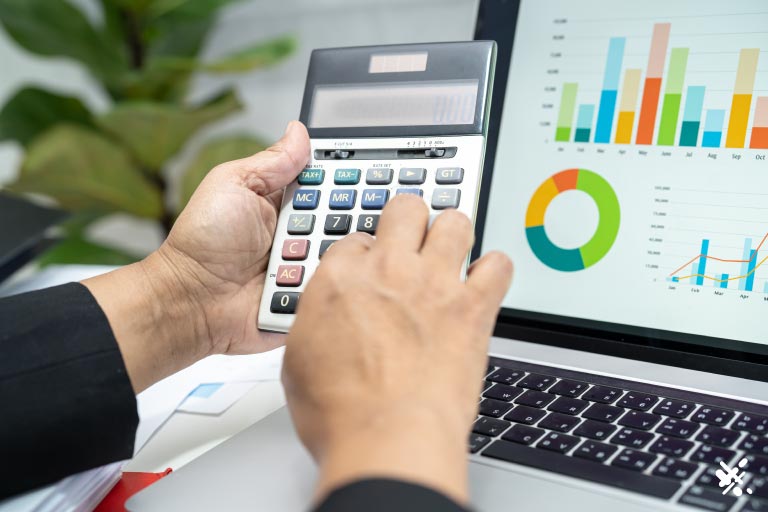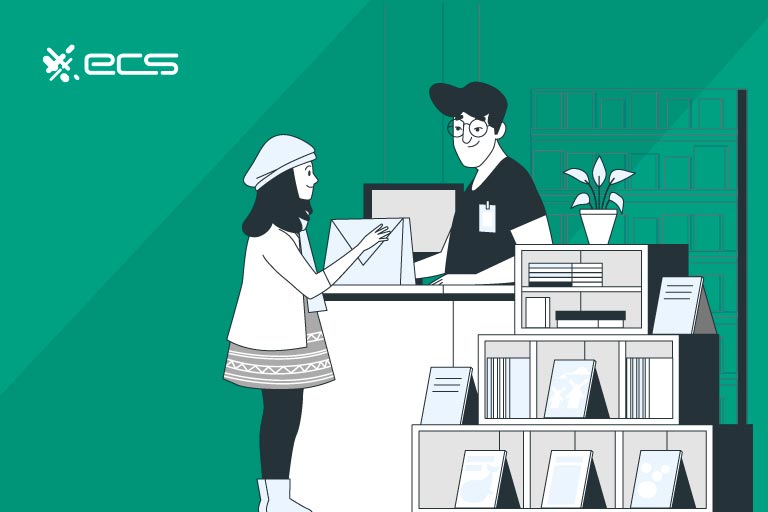Retail payment processing is all about facilitating the cash flow from customers’ bank accounts into the business’s merchant account. Retail payment processing is facilitated via card networks, issuing banks, payment processors, and retail payment systems that accept credit card payments.
In many ways, retail is the heart of the consumer economy. The total market valuation for retail was over $7 trillion in 2022, while the U.S. GDP was $23 trillion. Although that’s somewhat comparing apples to oranges (valuation to GDP), it shows you that retail is a significant chunk of our domestic economy.
As such, retailers are collecting millions of payments every day. More than millions, actually. Some estimates suggest more than a billion daily transactions in the U.S. alone. Retail payment solutions facilitate those transactions in the retail space, which comprises around 6% of our GDP.
Do retail stores have any unique challenges in terms of card payment processors? Isn’t retail card processing probably the same as any other business that takes credit cards? Yes and no…to be wonderfully ambiguous. Let’s look at some unique considerations that retail payment services must address.
Retail Vs. Wholesale
Retail is the sale of goods or services to consumers. It contrasts wholesaling, which is the sale of goods to businesses or selling B2B services to other businesses. A consumer is an end user who will “consumer” the goods they purchase for personal use. That could include everything from a bottle of Coke to a new dress.
Customer Experience
Online shoppers will quickly go to a different website if an online store page is slow to load or hard to navigate. And in-person shoppers will promptly go elsewhere if lines are long in brick-and-mortar stores.
In fact, 51% of shoppers will drop their merch and leave if they wait “too long.” How long is too long is a matter for further sociological study, but it’s easy to guess or use common sense.
One thing that makes a line seem long is when it’s slow-moving. Customers hate to see that each transaction takes several minutes and that the line crawls along “slower than a snail on sandpaper” (to quote a New Yorker, who will probably also let their opinion be known in such a line).

What Causes Long Lines in Retail Settings?
There are many potential culprits for long lines. Understaffing is one of them, one that almost 80% of businesses are experiencing. During the Covid Pandemic, many people mysteriously dropped out of the workforce, perhaps living on PUA allowances and playing lots of Mario Kart.
The workforce has yet to rebound, with understaffing still posing a significant challenge. Where all these employees have gone is a matter of speculation, much like we wonder where the Ancient Mayans went. Into the jungle? Abducted by aliens?
In any case, new trends in retail may reduce the impact of understaffing. Businesses are installing self-checkout registers (we’ll discuss that too). And they’re experimenting with robots and AI for restocking shelves and dealing with remote customer inquiries.
Legacy Payment Systems Are Slowing Your Game Down
But legacy retail payment processing systems can also be a long-line culprit. If every transaction at the payment gateway takes half a minute, that will slow things down. For decades, customers were used to swiping the magnetic strip on their credit cards. But these magnetic strips, and their static way of storing information, make them ripe for theft and fraud with card skimming (small machines installed clandestinely on the readers).
That’s why card companies will phase out the magnetic strip by 2033. What’s left are EMV chip payments and contactless payments. The thing is, one of these options is even slower than the magnetic strip: the chip. It takes around 13-15 seconds for a chip transaction to be completed, and that doesn’t even include the customer fumbling around in their wallet for one of their four credit cards.
When everything is done, the entire purchase could have taken two minutes. That’s a long time for a generation with an attention spanner shorter than that of a goldfish (in part thanks to excessive social media usage, psychologists say). Way too long! What gives? Why is this guy taking so long?
And so on, until customers either grab their pitchforks and torches or do something much worse…leave without coming back. After all, if pitchforks and torches are involved, retailers could get some insurance money. Plus, they could make a really awesome TikTok reel, which might bring in more business.
Contactless Retail Payments: Rapid, Easy, and Painless
This is where contactless payments come in. Retailers MUST (in capital letters) embrace the consumer trend toward contactless payments. More than 50% of American consumers are already regularly using contactless payments. The Covid pandemic accelerated this trend when consumers were concerned about the hygiene of touching card terminals.
Contactless payments take one or two seconds to complete. Because customers can use their phones with contactless payments, there is less rifling around in the old billfold. The radio-wave technology behind contactless cards and mobile payments is highly secure (more on that later). And it can facilitate a much faster checkout experience.
Retail Payment Processing Security
Our next consideration is card payment security. As we’ve already touched upon, contactless payments are more secure than magnetic strips (as are EMV chips). One reason is that these later methods are not static. They use randomly generated codes to encrypt payment information.
No one can unscramble the encryption but the card networks and perhaps the credit card processor. As a result, card skimming is useless because replicating the card does nothing. Each transaction has a unique signature, not a static set of data that are re-used again and again.
Contactless payments are also secure because the radio wave technology behind them is short-range. The payment will only be processed if the card is one or two inches within the airspace of the terminal. Near-field communication also effectively cuts out nearby payment pirates.
Biometrics: An Extra Layer of Security
Mobile contactless payments have an extra layer of security, which is biometric. Many phone service providers are putting biometric locks on digital wallets. So, a phone user cannot open their digital wallet without a fingerprint, facial, or retinal scan (of the eye). Unlike a plastic card, someone who appropriates a customer’s phone cannot effectively use it for making fraudulent payments.
Biometric payments may be the way of the future. Mastercard has already tested out pilot programs with retailers in Brazil. These programs allowed customers to subject their faces to a scan at the point of sale.
The goal for futuristic biometrics is that payments only authorize successfully if the face matches the face they registered with Mastercard. Consumer reception of the biometric pilot program was very favorable, and it may soon appear in the U.S. in limited settings.
How Can Retailers Improve Customer Experience and Safety?
To wrap up our discussion of customer experience and safety vis-a-vis contactless payments, let’s mention some best practices for implementation. Retailers must work with a payment processing company with up-to-date hardware and contactless readers.
They can also help encourage customers to use contactless payments with well-placed signage: we accept mobile payments. Retailers have put this sort of signage out for decades. For instance, the card networks usually send retailers a sticker to put in the window or billfolds to hand diners. You can do the same thing with your signage to encourage customers to use contactless payment methods.
Inventory Challenges And POS Analytics
Inventory is (for most retailers) the most expensive part of a business. Although numbers vary by industry, for every dollar a retailer makes, they have a dollar, three dimes, and one nickel in inventory (that’s $1.35 for those who don’t like inventory). In other words, the inventory cost is 35% more than their cash flow.
Excess inventory is a problem in this train of thought. But what can a retailer do? After all, the opposite problem is also…a big problem. Retailers overstock because they don’t want to be short on inventory. As 66% of consumers leave a store because it doesn’t have what they want, this is a legitimate concern.
That’s where retail payment processing solutions come into play once more. The POS software can be linked to an IMS (inventory management system). You might be wondering what is so special about that. Sure, it might make it slightly easier to see when you need to order more Charmin. But isn’t that something you can also do by checking the back?

Analytics In Retail Payment Processing
That’s where machine learning and AI come in. You can benefit from artificial intelligence even if you’re not using robots to restock shelves like they are over at Walmart. When your POS and IMS are integrated with analytic capabilities, you will understand more than just when to order more Charmin.
You will see what percentage of customers like extra-strong Charmin, what percentage likes extra-soft Charmin, and which ones just love Charmin. You’ll see how fast the 4-roll packs sell, how fast the 16-roll packs sell, and how fast the 24 or 48-roll packs sell. You’ll see what days Charmin is flying off the shelves (probably the day after Taco Tuesday, which is…Wednesday).
If you don’t sell toilet paper, you’ll get a nuanced picture of whatever you sell. You’ll be able to look over your dashboard and get a sense of what to order when to order, and what not to order anymore or order less of.
This is the power of analytics. Over time, you can reduce that average $1.35 down closer to a dollar. Less excess inventory equals cost savings. It means a well-oiled machine with what you need when you need it.
Analytics And Store Layout
But an integrated POS goes further than just managing inventory. It can even assist with the in-store layout. Continuing to reference our cited shopper abandonment survey, we see that an even blogger percentage of consumers (67%) leave because they couldn’t find the item they were looking for. Whether the store had it or not, they didn’t know.
Some of this is due to messy stores, which ties into concerns about understaffing and company culture. But some of this is due to dysfunctional store layouts. The importance of store layout has been known for centuries, with adages like “stack ’em high, watch ’em fly, stack ’em low, they won’t go.” If you see that certain items are struggling to move, you can attempt to get them going by moving them to more prominent locations.
You can also see that customers are purchasing certain items together. This can lead you to place the items next to each other or run promotions featuring both items. Amazon is working wonders with this kind of product recommendation. One-third of its sales come from product recommendations and 35% of its revenue.
POS-driven analytics may be the key to unlocking this opportunity for your business. Software and fintech companies are hopping on board this trend because they have realized that store architecture genuinely impacts a retailer’s revenue. There may be some additional tools that are needed, such as in-store video analytics or studies of foot traffic. Still, the inventory function of the POS is also a significant part of implementing successful store layouts.
Customer Rewards Programs
Another consideration for retail payment processing is loyalty programs. Nine out of ten businesses have a loyalty program. These programs give points to shoppers for transactions or visits.
They may also provide special ongoing discounts and privileges. Building brand trust is a slow process that takes three years for 88% of consumers, so loyalty programs are crucial for reducing customer churn.
In the past, retailers would keep track of points and rewards on paper cards. However, this practice is susceptible to fraud and loss (the customer losing the card). Software applications, especially phone-based apps, provide a better solution. Customers can use these apps to check in to a store location and get their points towards a reward.
Think of your favorite retailers. There’s a 90% chance they have some rewards program. And there’s also a decent chance their rewards program is cloud-based (a phone app and not a punch card). Sometimes geolocation is used to register points, but the points are often recorded by scanning a code at checkout.
This is where the retail payment processing systems come into play. The POS becomes the hardware for implementing the rewards program and keeping track of points. Your customers’ progress is not stored in the POS but sent to the cloud-based solution you are using, whether in-house or a third-party application.
This is a huge reason retailers cannot use old, legacy payment systems to process payments. They need something that will integrate with a loyalty app.

Transaction Fees and Interchange Rates
Customer experience, security, inventory, and customer retention… are just a few considerations that retailers must address in their payment systems. But how much is all this going to cost?
While the exact cost of retail payment processing will change, retailers should be aware of fee structures, at least in broad terms. Some structures disadvantage retailers because they are geared toward low transaction volumes.
Flat Rate Pricing is Not Good For Retail
The first culprit is flat-rate pricing. Flat rate pricing is perfect for retailers who are just starting. In fact, for online retailers, flat-rate pricing is almost unavoidable. This is because most online retailers need to use something like PaPal, Shopify, Stripe, or Square to get started.
If the retailer gets big enough to migrate to their website or decides to open a brick-and-mortar store, these payment processors may follow the merchant by offering hardware.
“It’s a trap,” as a squid-like being in Start Wars once said, making himself the subject of internet memes for generations to come (Admiral Akbar). These large retail payment processing companies typically offer flat-rate pricing. Flat rate pricing is terrible for high-volume merchants because it does not accurately reflect the actual price of each transaction. There could be hundreds or thousands of transactions each week that cost you much more than they should, all for convenience.

Tiered Pricing is Often Bad For Retail As Well
Next, there is tiered pricing. Tiers are like those levels in a baseball stadium. There are the good seats, and then there are the cheap seats. With tiered pricing, the case majority of your most desirable transactions (rewards credit cards, corporate credit cards, online payments) will cost you more.
That’s because the most expensive tier, non-qualified, comprises these transaction types. These transactions may be subjected to more fraud than those in the qualified and mid-qualified transactions (debit cards and non-rewards credit cards). For example, card-not-present or CNP transactions have a higher fraud rate (since the customer is not necessarily in front of you).
For some businesses, this is terrible business. If you have corporate customers, those customers are a significant percentage of your revenue. They probably also pay with corporate credit cards, which are in the non-qualified tier. Therefore, business-to-business payment processing is not well-served by tiered pricing.
But even your standard consumer becomes fee-heavy with this model. Consumers like to shop with rewards-based credit cards. And they also like to shop online. If you are a retailer using QR codes or text-to-pay solutions, these transactions are also technically card-not-present transactions (since they are done on a web page that the customer is directed to).
That said, tiered pricing is probably not advantageous to a retailer. It benefits the payment processor who wants to cover their risks from chargebacks. That’s why many banks that offer payment processing services will use this pricing model.
Interchange Plus Pricing: The Sweet Spot
Interchange plus pricing is the happy ending to the Goldilocks story…in other words, just right. In this pricing model, each transaction costs the merchant whatever Visa, Mastercard, Amex, and Discover say it costs, plus a standard markup for the payment processor. This differs from flat rate pricing, where the payment processor makes every transaction have the same processing fees.
Interchange fees vary from card to card. Amex is notoriously expensive, while Visa and Mastercard are on the lower end. But the actual picture is genuinely much more nuanced than that.
Each card network has hundreds of different prices for different categories of merchants, as defined by their MCC. Interchange plus pricing allows you to pay the actual cost of a transaction plus some markup to the payment gateway.
For most businesses, this is the best pricing model. And for retailers whose MCC codes are connected to the lowest fees, this is undoubtedly the best fee structure. Discussing this with your payment processor can determine if this is the case.
Retail Payment Processing: A Wrap-Up
Payment processing in retail needs to facilitate a great customer experience. It must integrate with IMS (and other software solutions, like accounting). It needs to have great pricing. And the payment processor needs to have stellar customer support.
You want to work with a payment processor who will respond to your needs as they arise. If there are challenges with the software or hardware, you cannot afford to let that problem derail your cash flow for the day.
If you want to know more about what good customer service means and how it can impact your operational experience, call or contact us via the form below.
